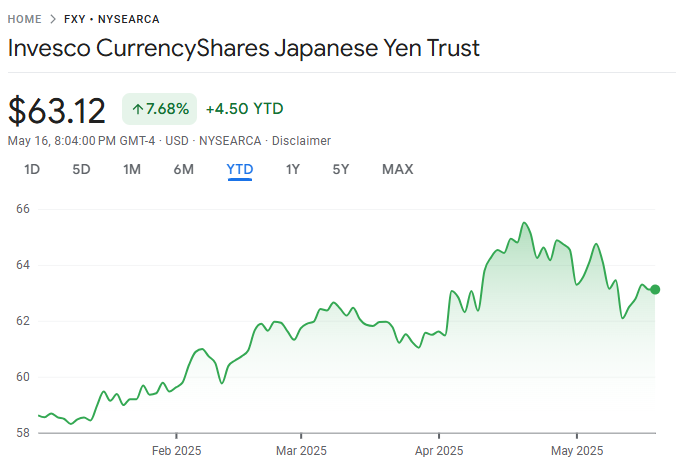Investing in a long-term Yen ETF may seem appealing, but is it a safe investment? Currency ETFs like these track the yen's value against the US dollar (USD).
As we approach 2025, volatility and risks remain significant. This article explores whether a long yen ETF is the right choice for you, highlighting its challenges and offering practical insights.
What Is a Long Yen ETF?

A long yen ETF is an investment that bets on the yen's appreciation. Funds like the CurrencyShares Japanese Yen Trust (FXY) mirror the yen's value. It provides a straightforward method for gaining exposure to the yen. However, its safety depends on market fluctuations.
Why Consider a Long Yen ETF?
The yen is often considered a safe-haven currency, attracting investors during times of uncertainty. In 2024, it appreciated by 7% amid global turmoil. A long yen ETF is a hedge against USD weakness, but high potential rewards come with inherent risks.
Volatility in Long Yen ETFs
The yen experiences sharp fluctuations. For instance, in 2023, FXY dropped by 5% in just one month, and daily volatility reached 1.2% in 2024. A long yen ETF can thrive or suffer based on these market swings.
Currency Risk Explained
Yen depreciation can be detrimental. For example, if the USD/JPY exchange rate increases from 145 to 155, a long yen ETF would lose 6%. In 2022, this scenario cost investors $500 for every $10,000 invested. This is a significant risk to consider.
Interest Rate Threats
Japan's interest rate is projected at 0.25% in 2025, much lower than the USD's 4%. This widening gap may weaken the yen. A long yen ETF declined by 3% following the Federal Reserve rate hike in 2024. Interest rates are a key factor to consider.
Market Sentiment Risks
Risk-off sentiment typically boosts the yen, while stable markets favour the USD. In the first quarter of 2024, a long yen ETF gained 4% amidst global unrest, only to reverse with a 2% loss during calmer market conditions. Sentiment can shift quickly.
FXY: A Popular Long Yen ETF

The CurrencyShares Japanese Yen Trust (FXY) is a leading ETF in this category, holding $300 million in assets with an expense ratio of 0.4%. It is a liquid option that still reflects the risks associated with the yen.
Hedging with Long Yen ETFs
If you own yen-denominated assets, a long yen ETF can help offset losses. In 2023, it effectively balanced a 5% dip in the stock market. However, if the yen depreciates, the hedging strategy can backfire. Assess your overall market exposure carefully.
Historical Performance Check
From 2020 to 2024, FXY averaged annual returns of 2.5%. The highest return was 7% in 2022, while the lowest was a 5% drop in 2023. A long yen ETF can provide modest gains but also substantial volatility.
Alternative
Leveraged ETFs such as YCL can double the yen's movements, but this also triples the risks. Consider options on USD/JPY for more control, or use gold as a safer hedge. A long-term ETF is not your only investment strategy.
Managing Volatility Risks
To mitigate risks, set stop-loss orders at 3% below your entry point. Diversify your portfolio with gold or bonds, and limit your position size to $5,000. In 2024, cautious traders who implemented these strategies reduced their losses by 10%. Do prioritise safety.
Tools to Track Safety
Utilise volatility indices like the VIX. Keep an eye on news regarding the Bank of Japan's rates. The Relative Strength Index (RSI) can help identify overbought conditions for the yen. Traders using these tools in 2023 outperformed FXY declines by 8%. Stay alert.
When It's Safe to Invest
The yen tends to perform well during crises. For example, in Q3 2024, a long yen ETF rose 5% amidst trade wars. It's wise to avoid investing during phases of strong USD strength. Proper timing can significantly reduce your investment risks.
Real-World Outcomes
A London investor made $1,200 on FXY during the unrest in 2024, while another lost $800 betting against the USD in 2023. This demonstrates how timing in a long yen ETF can bring substantial rewards or losses.
Pitfalls to Avoid
Avoid chasing yen spikes without research. Over-investing poses the risk of significant losses, and ignoring trends in the USD can also be costly. In 2022, 20% of long yen ETF holders miscalculated their bets. Knowledge is essential.
2025 Outlook for Long Yen ETFs

The yen may appreciate against the USD, potentially reaching 140. If interest rates stabilise, volatility could decrease, and a long yen ETF might return around 3%. Ongoing global unrest will likely keep it relevant.
Actionable Steps to Start
1. Review FXY's 0.4% expense ratio.
2. Test a long-term ETF using a demo account.
3. Set stop-loss limits at 3%.
4. Start with an initial investment of $2,000.
5. Monitor yen-related news weekly.
Conclusion
Safety varies widely. A long yen ETF may offer gains during chaotic periods, but it also carries significant risks, especially in a strong USD environment. Understanding market timing and setting limits will be crucial for successful investing in 2025.
Disclaimer: This material is for general information purposes only and is not intended as (and should not be considered to be) financial, investment or other advice on which reliance should be placed. No opinion given in the material constitutes a recommendation by EBC or the author that any particular investment, security, transaction or investment strategy is suitable for any specific person.
























